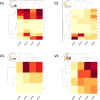Characterization of humoral responses to soluble trimeric HIV gp140 from a clade A Ugandan field isolate
- PMID: 23835244
- PMCID: PMC3729709
- DOI: 10.1186/1479-5876-11-165
Characterization of humoral responses to soluble trimeric HIV gp140 from a clade A Ugandan field isolate
Abstract
Trimeric soluble forms of HIV gp140 envelope glycoproteins represent one of the closest molecular structures compared to native spikes present on intact virus particles. Trimeric soluble gp140 have been generated by several groups and such molecules have been shown to induce antibodies with neutralizing activity against homologous and heterologous viruses. In the present study, we generated a recombinant trimeric soluble gp140, derived from a previously identified Ugandan A-clade HIV field isolate (gp14094UG018). Antibodies elicited in immunized rabbits show a broad binding pattern to HIV envelopes of different clades. An epitope mapping analysis reveals that, on average, the binding is mostly focused on the C1, C2, V3, V5 and C5 regions. Immune sera show neutralization activity to Tier 1 isolates of different clades, demonstrating cross clade neutralizing activity which needs to be further broadened by possible structural modifications of the clade A gp14094UG018. Our results provide a rationale for the design and evaluation of immunogens and the clade A gp14094UG018 shows promising characteristics for potential involvement in an effective HIV vaccine with broad activity.
Figures







References
Publication types
MeSH terms
Substances
LinkOut - more resources
Full Text Sources
Other Literature Sources
Medical
Miscellaneous

